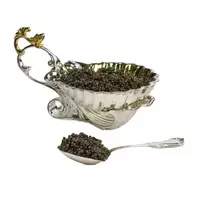Artificial black caviar

For a long time, black caviar of noble sturgeon fish species has been in stable demand and popular not only in our latitudes, but also around the world. Traditionally, black caviar is derived from fish species such as sturgeon, sevryuga, and thorn and beluga. The main fishery for the extraction and harvesting of black caviar is located in the waters of the Caspian and Azov Seas.
Black caviar, however, like red, differs not only in its sophisticated and refined taste, and also boasts a unique vitamin-mineral composition. Black caviar of fish such as beluga is considered a special delicacy. The chemical composition of black caviar contains amino acids essential for human health, and in addition, minerals and vitamins. For example, black caviar is enriched with significant amounts of potassium, iron, as well as phosphorus and magnesium.
It is worth noting that due to the unprecedented popularity of black caviar, sturgeon fish species suffer primarily. Sturgeon fish are declining annually due to the activities of poachers who harvest black caviar without observing conservation rules. Currently, some sturgeon species are successfully grown in aquaculture.
Back in the 70s of the last century, Soviet scientists set out to get a more affordable type of black caviar or, the so-called imitation of a natural product. Synthetic or artificial black caviar is nowadays considered a cheap alternative to a natural product. It is worth noting that artificial black caviar has absolutely nothing to do with a natural product, with the exception of perhaps appearance.
The thing is that the imitation only partially corresponds to the main parameters of natural caviar. Artificial black caviar appeared on the shelves of domestic stores already in the 80s. However, for a fairly long period of time, artificial black caviar was not in demand and popular with Soviet consumers.
This was not only due to taste. but also the consumer features of the product. True, over time, manufacturers have significantly improved the chemical composition of artificial black caviar. This greatly improved the quality of artificial black caviar. As a rule, gelatin, chicken egg white, as well as herring meat, food dyes and salt are used to produce artificial black caviar.
The composition of artificial black caviar without food dyes is not conceivable, since it is these compounds that help give the finished food product the characteristic taste features of natural caviar. Currently, improved variants of artificial black caviar are produced from sodium alginate, which is a granular jelly produced in the process of processing seaweed.
artificial black caviar 62 kCal
Energy value of artificial black caviar (Ratio of proteins, fats, carbohydrates - ju):
Proteins: 1 g (~ 4 kCal)
Fats: 5.4 g (~ 49 kCal)
Carbohydrates: 2.6 g (~ 10 kCal)
Energy ratio (bj | y): 6% | 78% | 17%
 Español
Español Français
Français Português
Português Русский
Русский 简体中文
简体中文 繁體中文
繁體中文 日本語
日本語 한국어
한국어 العربية
العربية Türkçe
Türkçe Қазақ
Қазақ Deutsch
Deutsch Italiano
Italiano Українська
Українська
